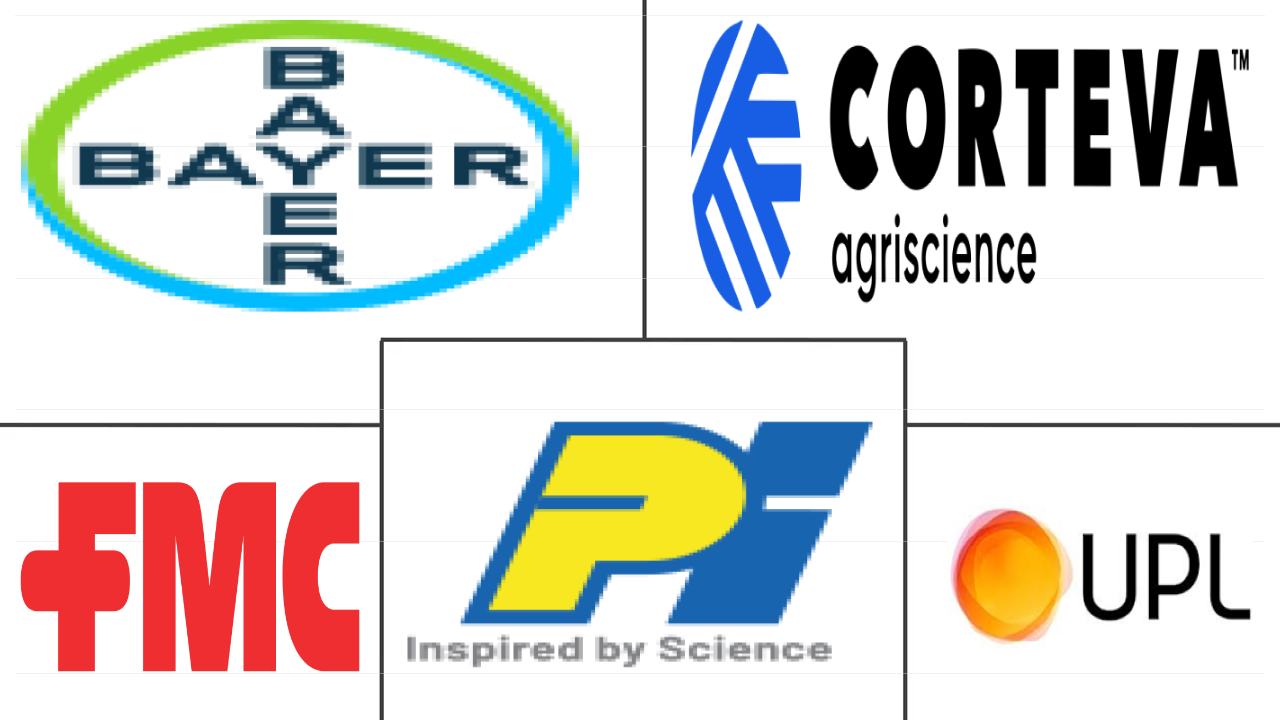Market Size of india herbicide Industry
| Icons | Lable | Value |
|---|---|---|
|
|
Study Period | 2017 - 2029 |
|
|
Market Size (2024) | USD 361.85 Million |
|
|
Market Size (2029) | USD 558.17 Million |
|
|
Largest Share by Application Mode | Soil Treatment |
|
|
CAGR (2024 - 2029) | 9.06 % |
|
|
Fastest Growing by Application Mode | Soil Treatment |
|
|
Market Concentration | Medium |
Major Players |
||

|
||
|
*Disclaimer: Major Players sorted in no particular order |
India Herbicide Market Analysis
The India Herbicide Market size is estimated at 361.85 million USD in 2024, and is expected to reach 558.17 million USD by 2029, growing at a CAGR of 9.06% during the forecast period (2024-2029).
361.85 Million
Market Size in 2024 (USD)
558.17 Million
Market Size in 2029 (USD)
7.94 %
CAGR (2017-2023)
9.06 %
CAGR (2024-2029)
Largest Segment by Application Mode
46.50 %
value share, Soil Treatment, 2023
Farmers are increasingly embracing this soil application of herbicides as it effectively manages weed seeds and seedlings while forming a protective barrier in the soil.
Largest Segment by Crop Type
44.72 %
value share, Grains & Cereals, 2023
Weeds are causing major crop loss in the grain and cereal sector. The losses caused by weeds in prominent crops include rice (41.6%), wheat (16%), and maize (39.8%).
Fastest-Growing Segment by Crop Type
9.27 %
Projected CAGR, Commercial Crops, 2024-2029
The sector is growing faster due to expanding cultivation areas, the adoption of intensive agricultural practices, and the implementation of effective weed management strategies.
Leading Market Player 1
17.62 %
market share, Bayer AG, 2022

Bayer AG is a pioneer in developing new products. The company has planned to develop new products that are environment and human-friendly, through its partnership with Oerth Bio.
Leading Market Player 2
13.02 %
market share, UPL Limited, 2022

UPL Limited The company offers 24 herbicides containing Metolachlor, Bispyribac Sodium, Oxyflourfen, 2,4-D Amine salt, and Glufosinate Ammonium to control pre and post-emergent weeds.
The primary mode of herbicide application of utmost significance is the soil treatment application
- Weeds pose a significant threat to the agricultural sector in India, resulting in substantial annual crop losses of around 45.0%. Farmers are implementing various strategies, including crop rotation, cultural practices, manual weeding, and spraying chemical herbicides to control weeds.
- However, due to rising production costs associated with alternative methods, more farmers are adopting chemical herbicides to tackle weeds in their crops. Farmers can efficiently control weed growth and minimize the detrimental effects on their agricultural yield by spraying herbicides.
- There are various application modes for weed control. Soil treatment using herbicides holds a prominent share due to its effectiveness in managing weeds during their early growth stages. This application method has gained popularity among farmers cultivating grain and cereal crops due to its advantageous effects in controlling pre-emergence weeds.
- Soil treatment involves applying herbicides directly to the soil, where they can effectively target weed seeds and emerging seedlings, inhibiting their growth and establishment. By employing soil treatment applications, farmers can proactively address weed issues and promote healthier crop growth in the crucial early stages.
- Following the soil treatment mode, other application modes such as foliar and chemigation have witnessed a surge in popularity for weed control in the country. These modes have demonstrated their effectiveness and offered various benefits in enhancing crop productivity. In 2022, foliar and chemigation registered a significant market share of 33.1% and 18.7%, respectively.
India Herbicide Industry Segmentation
Chemigation, Foliar, Fumigation, Soil Treatment are covered as segments by Application Mode. Commercial Crops, Fruits & Vegetables, Grains & Cereals, Pulses & Oilseeds, Turf & Ornamental are covered as segments by Crop Type.
- Weeds pose a significant threat to the agricultural sector in India, resulting in substantial annual crop losses of around 45.0%. Farmers are implementing various strategies, including crop rotation, cultural practices, manual weeding, and spraying chemical herbicides to control weeds.
- However, due to rising production costs associated with alternative methods, more farmers are adopting chemical herbicides to tackle weeds in their crops. Farmers can efficiently control weed growth and minimize the detrimental effects on their agricultural yield by spraying herbicides.
- There are various application modes for weed control. Soil treatment using herbicides holds a prominent share due to its effectiveness in managing weeds during their early growth stages. This application method has gained popularity among farmers cultivating grain and cereal crops due to its advantageous effects in controlling pre-emergence weeds.
- Soil treatment involves applying herbicides directly to the soil, where they can effectively target weed seeds and emerging seedlings, inhibiting their growth and establishment. By employing soil treatment applications, farmers can proactively address weed issues and promote healthier crop growth in the crucial early stages.
- Following the soil treatment mode, other application modes such as foliar and chemigation have witnessed a surge in popularity for weed control in the country. These modes have demonstrated their effectiveness and offered various benefits in enhancing crop productivity. In 2022, foliar and chemigation registered a significant market share of 33.1% and 18.7%, respectively.
| Application Mode | |
| Chemigation | |
| Foliar | |
| Fumigation | |
| Soil Treatment |
| Crop Type | |
| Commercial Crops | |
| Fruits & Vegetables | |
| Grains & Cereals | |
| Pulses & Oilseeds | |
| Turf & Ornamental |
India Herbicide Market Size Summary
The India Herbicide Market is experiencing significant growth, driven by the increasing need for effective weed management solutions in the agricultural sector. Weeds are a major threat to crop yields, causing substantial losses and prompting farmers to adopt chemical herbicides as a cost-effective and efficient method of control. The market is characterized by a variety of application modes, with soil treatment being particularly popular due to its effectiveness in managing pre-emergence weeds. Other methods such as foliar and chemigation are also gaining traction, contributing to the market's expansion. The shift from traditional manual weeding to mechanized and chemical-based approaches is a notable trend, as farmers seek to enhance crop productivity through repeated cropping cycles and the use of genetically modified crops that tolerate herbicides.
The market is moderately consolidated, with major players like Bayer AG, Corteva Agriscience, FMC Corporation, PI Industries, and UPL Limited dominating the landscape. These companies are actively involved in partnerships and collaborations to develop innovative and eco-friendly crop protection solutions. The government's support for the rural economy and agriculture sector, along with the availability of a wide range of herbicides, is expected to further influence market dynamics. Key herbicides such as Atrazine, Paraquat, and Glyphosate are widely used, with Atrazine being a significant import due to its extensive application in crops like maize and rice. The market's growth is also supported by the increasing awareness among farmers about the benefits of herbicides and the ongoing development of specialized weed control solutions.
India Herbicide Market Size - Table of Contents
-
1. MARKET SEGMENTATION (includes market size in Value in USD and Volume, Forecasts up to 2029 and analysis of growth prospects)
-
1.1 Application Mode
-
1.1.1 Chemigation
-
1.1.2 Foliar
-
1.1.3 Fumigation
-
1.1.4 Soil Treatment
-
-
1.2 Crop Type
-
1.2.1 Commercial Crops
-
1.2.2 Fruits & Vegetables
-
1.2.3 Grains & Cereals
-
1.2.4 Pulses & Oilseeds
-
1.2.5 Turf & Ornamental
-
-
India Herbicide Market Size FAQs
How big is the India Herbicide Market?
The India Herbicide Market size is expected to reach USD 361.85 million in 2024 and grow at a CAGR of 9.06% to reach USD 558.17 million by 2029.
What is the current India Herbicide Market size?
In 2024, the India Herbicide Market size is expected to reach USD 361.85 million.

